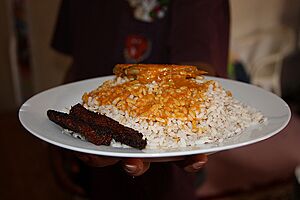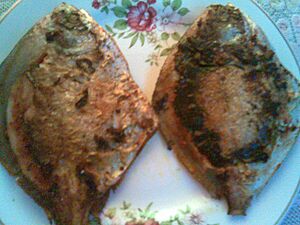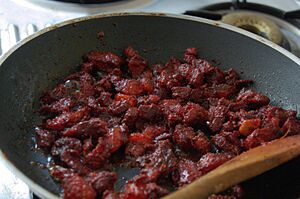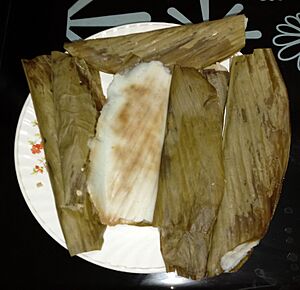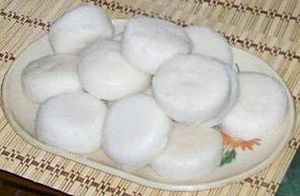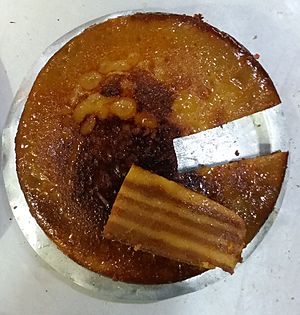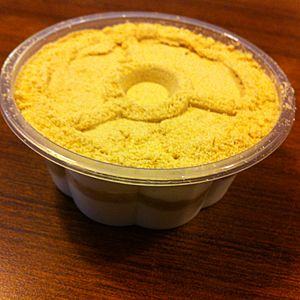Goan Catholic cuisine facts for kids
Goan Catholic Cuisine is the traditional food of the Goan Catholic people. This unique cooking style has been shaped by many cultures. It mixes flavors from Saraswat, Konkani, Portuguese, South Indian, and British cuisines. For over 450 years, Goa was ruled by Portugal. This long history means Portuguese cooking methods and ingredients are very important in Goan Catholic food. You'll find dishes that are deep-fried or oven-baked. Pork, vinegar, and egg-based desserts are also common.
Delicious Non-Vegetarian Dishes
Goan Catholic cooking has many tasty meat dishes. The Portuguese influence is very clear here. For example, Assado de Porco is a famous roasted pork dish. It often takes center stage at wedding dinners. Sarapatel is another well-known pork dish. There's also Cabidela, a traditional way of preparing pork that uses a special ingredient for its unique flavor.
Many curries use a lot of spices and vinegar. Xit Kodi is a very important meal for the community. Xit means parboiled or red rice, and Kodi means fish curry. It's a staple food that people eat often. Other popular dishes with Portuguese roots include Chouriço (a type of pork sausage), Vindalho, Peixe Recheado (stuffed fish), and Xacuti (a rich curry).
For snacks, the Chamuça is a Goan version of a samosa. It's usually filled with minced beef or minced pork. Beef croquettes and prawn rissoles are also common quick bites. At Goan parties, sliced roast beef and beef tongue are popular starters. Some traditional pickles, like Molho de Peixe (fish pickle) and Balchão (prawn pickle), actually came from Macau.
Sweet Treats and Vegetarian Delights
Goan Catholic cuisine also offers many delicious vegetarian dishes and sweets. Patoleo are sweet rice cakes. They are steamed inside turmeric leaves and filled with coconut and palm jaggery. These special cakes are made for important celebrations. These include the Feasts of the Assumption of the Blessed Virgin Mary on August 15, Saõ João (Nativity of Saint John the Baptist) on June 24, and Konsachem fest (the harvest festival) in August.
Other popular vegetarian foods include Pez (a type of congee or rice porridge), Koiloris, and Podecho (pancakes). The Sanna is another favorite. It's made from soaked rice and coconut toddy, which gives it a unique taste.
For sweets, Kadio bodio are tiny sticks made from wheat flour. They are dipped in sugar syrup or jaggery and then dried. You can often find them as bestsellers at local fairs. Other popular sweets include Revdyo, Tizan, Godshem, and Filhoses (a stuffed pancake). Arroz doce is a Portuguese rice pudding that includes eggs. Neureos are deep-fried pastries filled with dried coconut, nuts, raisins, and sugar. Kulkul is a curly, deep-fried sweet dough made with eggs and wheat. Bolinhas are small coconut cakes. Perada is a candy made from guava. Batica is a moist, rich coconut cake. Maçapão is a sweet made from cashewnut marzipan, often shaped like fruits and vegetables. Dôce de grão is a sweet dish made with chickpeas and coconut. Finally, Bebinca is a very famous Goan dessert. It's a rich, multi-layered sweet dish made with eggs, and Goa is well-known for it.


